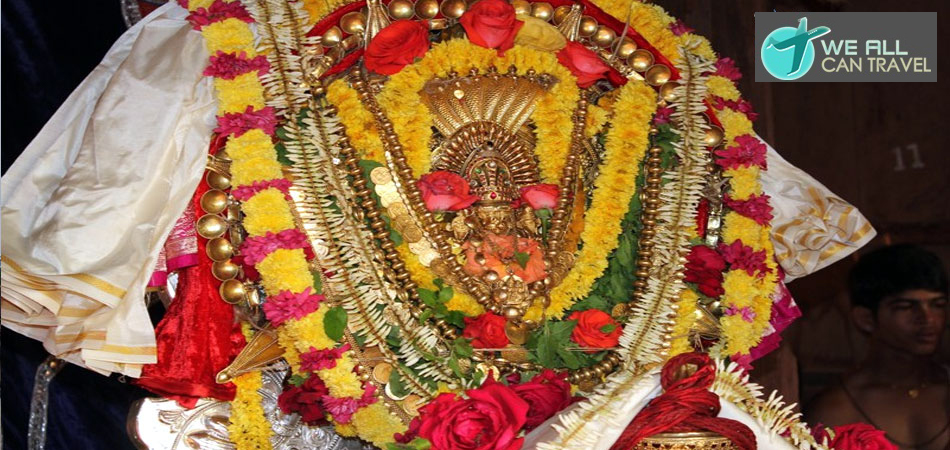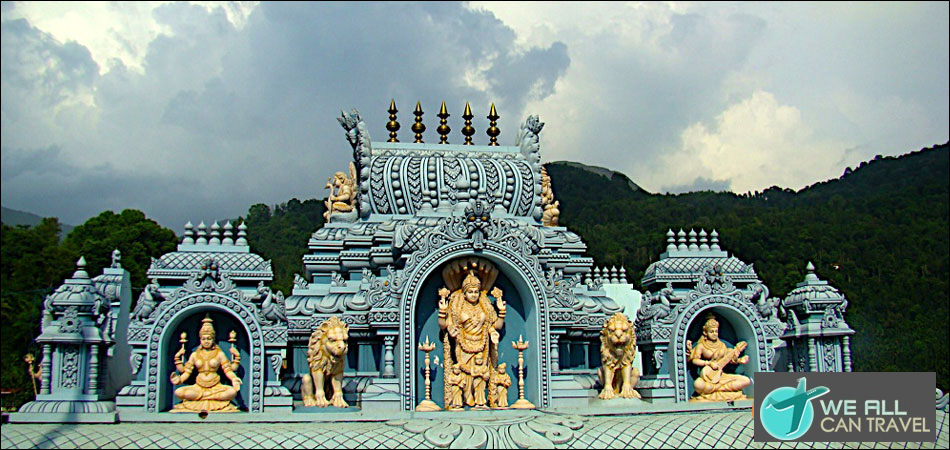Pannaka Narasimhaswami Temple
The temple of Sri Panakala Lakshmi Narasimhaswamy is situated on the hill. On the right side of the steps provided to reach the temple, there is a stone inscription by Sri Krishnadeva Raya of Vijayanagar and a little further up, the footprints of Mahaprabhu Chaitanya can be seen. Midway on the steps there is a temple of Lord Panakala Lakshmi Narasimhaswamy there is only the face with the mouth widely opened. A dhwajasthambha was erected in front of the temple in 1955. Behind the temple there is the temple of Sri Lakshmi, to the west of which there is a tunnel that is believed to lead to Vundavalli caves on the banks of the Krishna. The stone inscription of the kings of Vijayanagar relate besides to the conquest of Rayalu over Kondapalli etc., that Siddhiraju Thimmarajayya Devara granted a total of 200 kunchams (10 kunchams make one acre) land in 28 villages of which Mangalagiri was one and gift of 40 kunchams by Chinna Thirumalayya to Ramanujakutam. Sri Channapragada Balaramadasu constructed the steps to the temple in 1890. There is a cave next the Lakshmi Devi temple on the hill. It is said that, there is a way to Vundavalli from that cave, and the sages used to go by that way to take bath in Krishna River. Now, the cave is very dark, and the way could not be seen.
Demon Namuchi
The Lord who has established himself on the hill is in the form of Narasimha (man-lion), which Lord Vishnu assumed to kill Hiranyakasipu, a rakshasa father of Prahlada, a great devotee. He is also called as Sudarsana Narasimhaswamy. The legend says that Namuchi, a Rakshasa after great penance obtained a boon from Brahma that he would not be killed by anything that is either wet or dry. He began to harass Indra and the Devathas. Encouraged and supported by Lord Vishnu, Indra commenced destroying the army of Rakshasa Namuchi, who hid in a cave in Sukshmakara (small size) giving up his sthulakara (Physical manifestation). Indra dipped Sudarsana, the disc of Lord Vishnu in the foam of the ocean and sent it into the cave. Lord Vishnu manifesting himself at the centre of the disc destroyed the Pranavayuvu (life breath) of the Rakshasa with the fire of his exhalation. He thus got the name of Sudarsana Narasimha. The blood that flowed from the body of the Rakshasa seemed to have formed into a pool at the foot of the hill. The Devathas themselves were unable to withstand the anger of the Lord and they prayed for appeasement. The Lord drank amruta (nectar) and cooled down. This happened in Krithayuga. The Lord said that he would be satisfied with ghee in Threthayuga, with milk in Dwaparayuga and with panakam (Jaggery water) in Kaliyugam. Hence the Lord is called in Kaliyuga as Panakala Lakshmi Narasimhaswamy.
Story in Threthayuga
In Threthayuga, the second of the four yugas, people who were in heaven as a result of their good deeds in the world were most unwilling to return to this world (when once the fruits of good deeds are exhausted, the soul has to come back to the world). They prayed Indra, the Lord of heaven to save them from the impending fate. Indra advised them to spend their time in the world at Mangalagiri to attain heaven again. In Krithayuga, the first of the four yugas when the sinners were few, Yamadharmaraja, the Lord of hell advised them to wash off their sins by doing penance at Mangalagiri.
Mangalagiri is in existence from the beginning of the Universe with the names Anjanadri in Krithayuga, Thotadri in Threthayuga, Mangaladri and Mukthyadri in Dwaparayuga and Mangalagiri in Kaliyugam affording salvation to sinners also. In Krithayuga, Vaikhanasa Maharshi worshipped the Lord and the idol is worshipped even today in the temple. It is also believed that Lord Rama while departing for Vaikunta after completing his mission in that incarnation advised Anjaneya to stay at Mangalagiri and after obtaining his blessings to remain in this world forever. Anjaneya took his adobe at Mangalagiri as Kshetrapalaka.
 >> Agasteeshwara Temple
>> Agasteeshwara Temple >> Anantha Padmanabhaswami Temple
>> Anantha Padmanabhaswami Temple >> Ananthasana Temple
>> Ananthasana Temple >> Annapoorneshwari Temple
>> Annapoorneshwari Temple >> Arunachaleshwar Temple
>> Arunachaleshwar Temple